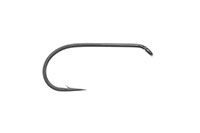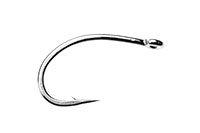
In the Lake Kamloops --Vol.32--
Mealtime
I returned to the lodge at lunchtime and went straight to the owner to ask why he had said that I would catch fish after 10a.m. He answered simply that it was a regular pattern. I asked again whether there was no exception and why it always happened. He explained to me as follows.Fish in the lakes here take meals twice a day, in the morning and the evening. Mealtime changes a little in a year but not so much. Their schedule changes in early summer and midsummer when mayfly and sedge are hatched respectively.
The season when fish eagerly make rises was over around here. It is the off-season now, so fish start eating at regular time in the morning and the evening.
Well, I took notice of his words that he opened the lodge especially for our tour. Ah, it is no good regretting it now. All I could do was to ask him how to fish in the off-season. He taught me 2 good ways.
One is to go to a lonely lake. A virgin spot usually has big fish and we have a chance to catch them.
The other is to keep fishing patiently until late evening.
Both methods had nothing special but fishing chance sounded high. I decided to try both methods.

Meadow Lake in the morning. It was quite calm and there was no sign of living creatures. Where are fish and what do they eat?
The Channel and the Beaver House
I spent much time with my lunch and got on a boat again nearly 3p.m. As I was going to fish Flapjack in the afternoon I had asked the owner about fishing points. There were 2 main points. One was in front of the small tail of the current. The other was in front of the beaver house in the innermost part.
Near the head and the tail of the current a lot of fish came in the evening.
The tail of the current as well as the head of it is the area where the largest amount of the water flows. Most of a huge number of lakes in Kamloops are linked with each other through channels that are too small to be called rivers. Each lake usually separates at low water and is linked with the next lake through the channel at high water. The area of Kamloops has particularly low temperature in winter. When both low water and cold winter come together, the bottom of the lake as well as the surface freezes and sometimes trout die. Local people call that accident winter kill. However, due to channels, trout come from the next lake again and the lake revives as a trout lake. That was what I heard.
I also learned that a lot of fish came to channels in the spawning season. It is September now. So I can aim at them!
The other spot, the beaver house, I hear, is built near the deepest spot of the lake. Beavers bite down some trees and pile them up to make a dam, in which they spend the winter. They chose a warm place with thin ice under which they can come and go freely. Both the deepest spot and the spot where groundwater springs satisfy beaver's needs. Those spots are suitable for fish to stay, too. The front of an empty old beaver house is always a good fishing point.

A beaver house whose residents left several years ago. The front of it is always a good fishing point.

Flapjack was very calm. Fish's mealtime was my fishing time.
Evening Meal in Flapjack
Somehow I felt the beaver house was more preferable. I dropped the anchor and began to fish in front of the remains of dam. The first fish came to me quite soon. Shortly after the line settled on the water I got a bite. That means fish stayed just under the surface. I cast the fly again, while I took intermediate line from my bag and loosened it for change. Suddenly I heard a short sound like a creak and the rod on the bottom of the boat moved some distance.Whew! That was a close call. If I had noticed a little later my rod would have disappeared into the water. A bite of the fish here is really wild!
I got one bite after another until dark in the evening. Unfortunately fish size was not so big but only 40cm at most.

At evening rise an average fish size became a little bigger.
Hiking
The next morning we three (my tour group) headed for a faraway lake. The owner said we had no need to worry about getting lost because the road went straight to the lake. We believed him and started walking on the mountain road. We heard it took us an hour and a half but soon found it to be hard work.It was dark inside the conifer forest. We were surprised whenever a grouse appeared from underfoot or a coyote passed in front of us. Moreover, a shiver ran through us to know the lake we had taken a detour to avoid was named "Grizzly Lake", which suggests grizzly bear.

Lonely "Grizzly Lake".
After we crossed the lake in a boat we arrived at the lake. An hour and a half hiking was over. The lake named "Tahoola" spread secretly deep in the forest. Only a few anglers throughout a year visited here, so the owner said. Surely, no angler would come here unless there were a chance to get a very big fish.
We turned over the boat at its mooring to remove the inside water and sailed for the centre of the large lake. We wondered whether fish stayed there. The surface was quite calm and there was no rise of even small fish.
I thought how to fish the spot. Because we needed an hour and a half again on our way back we could spend at most 3 hours in fishing. The lake was too large to move from one fishing spot to another. I would have done nothing but rowed the boat. Nevertheless, only hauling was not my taste.
I sailed for the centre of the lake, remembering how I used to fish bass in Lake Tsukui in Japan. Lake Tsukui in those days had scarce space where anglers could walk down the bank. Therefore we could not easily change the fishing spot but were obliged to fish patiently at one spot. When I cast the lure at a stable pace bass came to the lure from somewhere and I could catch them. Now I did not know the situation. I had no time, either. I decided to try Tsukui method here. I looked around the land shape and looked for the suitable place.

Probably because anglers seldom came here, size and shape of fish in Tahoola were greatly bigger.
Attracting Fish by Sound
I found a little peninsula 100m ahead, from where I could widely look around the surface. I dropped the anchor at the tip of the peninsula to moor the boat. I thought I would not overlook any rise. I chose size 8 Professor because it made great performance on the previous day. There was no definite point. I cast the line and retrieved it again and again.Half an hour passed. Nothing happened. Then nearly an hour passed. When I thought I had to give up I felt a strong bite. It was a beautiful rainbow trout of 40cm. Its style was a little different from those of Flapjack. It had a bold body and a small mouth like a fat Japanese dace.
Less than 5 minutes later the second fish snatched my fly. It was a little bigger than the first one. Another 5 minutes later the third fish pulled the line as powerfully as the previous two.
Then I had no bite at all. Well, anyway, my strategy proved to be successful.
Did the fish come from a faraway spot when they heard the fly and the line falling down on the surface just as bass do? Or did a shoal of some fish happen to pass nearby? I did not know which was true. Anyway, 3 rainbow trout discovered my little fly in the large lake. It was sure that casting the fly patiently at a stable pace helped me.
-- To be continued --
- NET SHOP INFORMATION

SL6 Black Spey Hooks

DU3 Limerick Spinner Hooks

SL4 Single Bartleet Hooks

XD1 Tube Fly Double Hooks

DD2 Flat Perfect Hooks

DD1 Black Terrestrial Hooks

TD4 Old Limerick Wet Hooks

DU1 Silver May Hooks

MU1 Flat Midge Hooks

LD3 Long Limerick Hooks

TD2 Summer Sproat Hooks

XS1 Tube Single Silver Hooks

TD6 Siver Sedge Hooks

SL5 Black Spey Hooks

DU3 Limerick Spinner Hooks
- TROPHY CLUB
- FLY SHOW
- EXHIBITION
- MASTERS`
- FLY DRESSING CONTEST Archives
- TRAVELLER Archives
- TACKLE IMPRESSIONS Archives
- ANGLERS` PHOTO GALLERY Archives
- ----------------------------------------------
- トロフィークラブ
- フライショー
- エキシビション
- マスターズ
- フライドレッシング・コンテスト・アーカイヴ
- トラヴェラー・アーカイヴ
- タックル・インプレッション・アーカイヴ
- アングラーズ・フォトギャラリー・アーカイヴ
株式会社サワダ 185-0021 東京都国分寺市南町3-13-4
SAWADA'S INC. 3-13-4 Minamicho, Kokubunji, Tokyo 185-0021, Japan
写真・ドキュメントの無断転載を禁じます。
All the images and documents found on this site are owned by Ken Sawada and may not be used without permission.
But, link to this site is FREE.
Copyright © 2000 - 2026 SAWADA'S INC.. All rights reserved.
SAWADA'S INC. 3-13-4 Minamicho, Kokubunji, Tokyo 185-0021, Japan
写真・ドキュメントの無断転載を禁じます。
All the images and documents found on this site are owned by Ken Sawada and may not be used without permission.
But, link to this site is FREE.
Copyright © 2000 - 2026 SAWADA'S INC.. All rights reserved.
